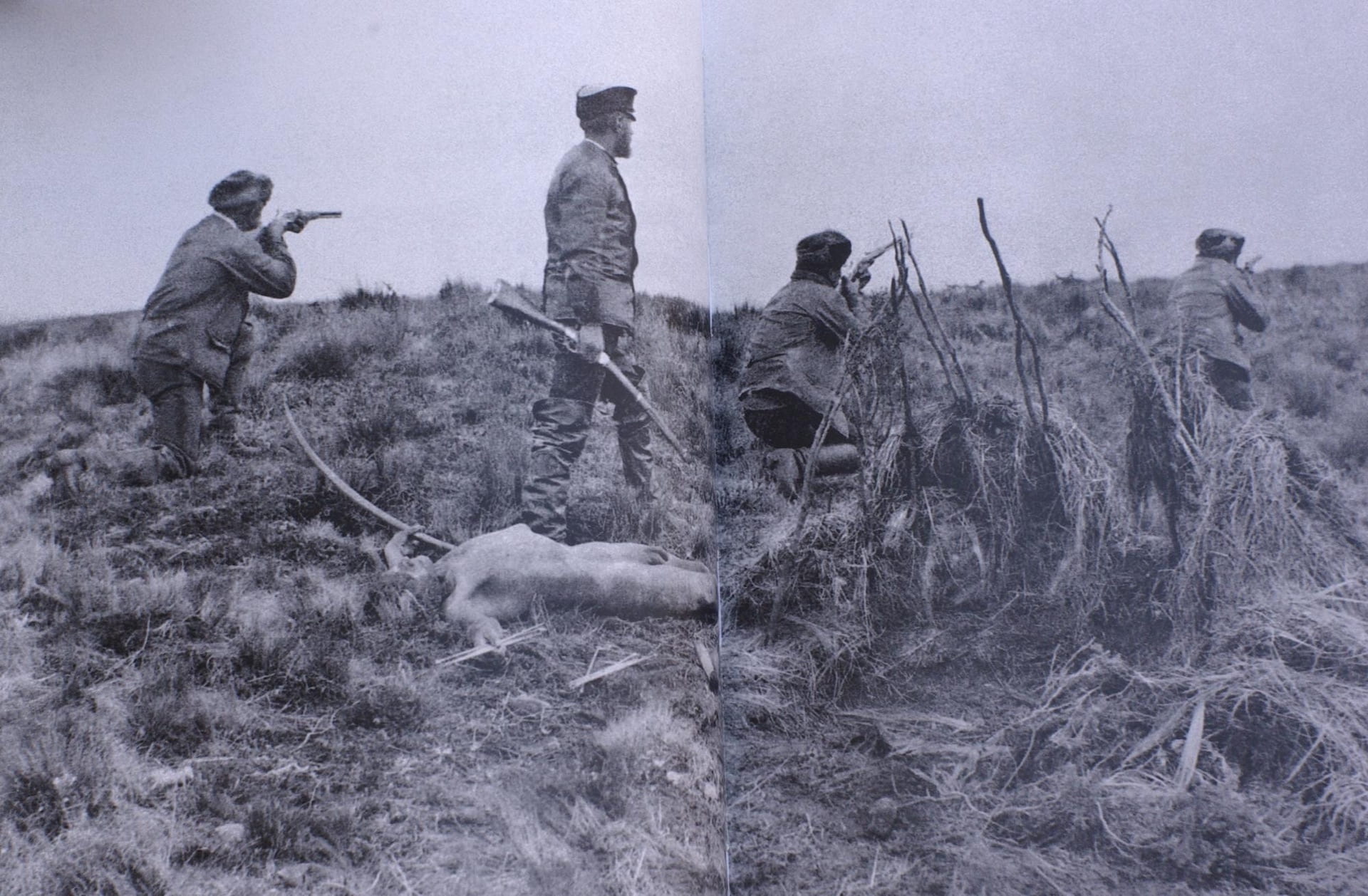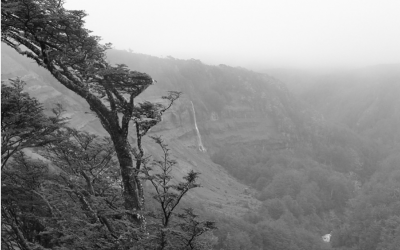In Dire Straits
Charles Darwin and Fuegians

Julius potter, 1886, randomly killing ona indians of tierra del fuego. Photo from: Ann Chapman, end of a world: the Selknam of tierra del fuego, Santiago, Chile, Taller Experimental Cuerpos Pintados, 2002.
In early 1968, while traveling as a Peace Corps Volunteer to the Galapagos Islands aboard the Ecuadoran navy supply boat B.A.E Calicuchima, I first read Darwin’s Voyage of the Beagle. The most important chapter was, of course, “The Galapagos Archipelago.” After all, his observations on finches and tortoises clearly illustrated adaptation and the origin of species, thus defining evolution. But having read On the Origin of Species as a student, the Galapagos narrative did not seem to be a spontaneous travel account nor a deductive rendering of the evolutionary ideas. Later I learned that scholars, as well as the family and admirers of Darwin’s close competitor Alfred Russell Wallace, demonstrated how Darwin’s travel account became more “evolutionary” with each edition, serving to cement his claims to originality as well as chronicling his maturing analysis. So, while Darwin’s Galapagos story was obviously dramatic for science, it was not a thriller to me then.
By contrast, the earlier chapter titled “Tierra del Fuego” It was alive with adventure, uncertainty and drama, as well as some startlingly subjective observations on the region’s indigenous inhabitants. Here Darwin apparently felt no need to justify any emerging theory . The seas of the Antipodes were nothing like the calm, predicable, mid-latitude waters of the Galapagos, where well-laid courses and controlled exploration could be realized. Consider this January 1833 entry:
At noon a great sea broke over us, and filled one of the whale boats right up which was obliged to be instantly cut away. The poor Beagle trembled at the shock, and for a few minutes would not obey her helm. Had another sea followed the first, our fate would have been decided soon, and for ever. We had now been twenty-four days trying in vain to go westward…
Likewise, the people were like none he had even imagined. On Christmas day 1835, he writes that the crew went on shore near Wolloston Island where they “pulled along side a canoe with six Fuegians [Indians]. These are the most abject and miserable creatures I anywhere beheld.” A week earlier, on observing an attempt at communication, he writes that the Fuegians, apparently mimicking the crew, were
… talking and making gestures with great rapidity. It was without exception the most curious and interesting spectacle I ever beheld. I could not have believed how wide was the difference between savages and civilized men.” But even these tall guanaco skin-clad Selk’nam (Ona) were, he added “… a different race from the stunted, miserable wretches [Yamana] farther westward…
After reading these thrilling chapters, I dragged a hesitant spouse and two friends to Punta Arenas on vacation in 1969. No one was disappointed by the landscape of Patagonia and the Straits of Magellan. And there were wonderful museums filled with huge stuffed rodents, sea birds, and man-sized ostriches (Rheas), all nearly extinct.
But it was the ethnographic photographs by Austrian missionary Father Martin Gusinde and the single shot, an apparent self-portrait, of Julius Popper hunting Selk’nam in the 1890s that plunked these exotic images into a harsh and sudden history. Within about seventy years of the Beagle’s voyage, the Indians of Tierra del Fuego—Selk’nam (Ona) and Huash to the east; Alacaluf and Yamana (Yaghan) to the west—were extinct as distinct and viable societies. By the late 20th century all but about two of the Fuegians were dead, most of the others having been killed by Europeans or perished from introduced illnesses.
Charles Darwin, of course, played no role in this. But his observations, like those of the Beagle’s captain, Robert FitzRoy, clearly project mid- and late 19th century European notions of hierarchical human evolution, and reveal the sentiments easily put into practice when European came into competition with these “others.” In an odd irony, Darwin’s thoughts while aboard the Beagle capture the shallow anthropological notions and ethnocentric morality of his times, while his observations on all other natural life illuminate the dynamics of natural science, which he would change forever.
This shipboard convergence of ideas and history—as the Age of Exploration settled to one of charting, commerce, and imperialism on the oceans; as the finding of natural science changed forever the way people see history and, less memorably, as a new anthropology mixed science, evolution, and “race” with short-sightedness and greed—produced a travel account easily placed alongside Homer’s Odyssey, Marco Polo’s travel and Captain Cook’s journals.
People, Islands, And Straits: An Earlier Evolution
The Fuegians have long figured in travelers accounts. Both Magellan and Drake spotted signal fires (fuego in Spanish) as they traveled here and, rumor has it, thus named the Land of the Fires, or Tierra del Fuego. But, long-time resident Lucas Bridges suggests (and we will read shortly) that both this naming tale and stories about cannibalism may be simply a part of the wild landscape’s lore. Residents and their inhospitable landscape only occasionally received travelers, who had their hands full simply navigating the stormy area, but, as they are mentioned by all travelers, it’s clear that the Fuegians had been on the island for a long time. Perhaps a very long presence, as archeologists now suggest.
Who, then, are these various peoples, almost as different one from another as from their observers? How did they get there? It turns out to be an interesting laboratory with an answer not suspected by Darwin but nonetheless consistent with his notions of competition and adaptation applied to other species. Reflecting on his notes, he asked:
Whilst beholding these savages, one asks, whence have they come? What could have tempted, or what change compelled a tribe of men, to leave the fine regions of the north to travel down the Cordillera or backbone of America, to invent and build canoes, which are not used by the tribes of Chile, Peru, and Brazil, and then to enter one of the most inhospitable countries within limits of the globe?
Surprisingly unlike the evolutionist that he was who assumes competition, Darwin here seems to suggest that the western Fuegians somehow decided to travel there. But archeology a century later illustrates a pattern that looks more toward population pressure than simple decision, thus foreshadowing the travails that would affect the Fuegians even more dramatically after Darwin left the Straits. As he notes, clear physical differences exist between the western coast’s short, squat shore-dwelling, canoe-using hunters and the notably tall hunters of the eastern plains. The pioneering archeology of Junius Bird suggests not only a long human presence for both groups (9,000 BC, and most would now argue, much earlier). However, associated arrow heads and spear points suggest an economy of plains-dwelling large game hunters, much like the Selk’nam and bearing no resemblance to the coastal Yamana. Other archeologists, notably Donald Lathrap, argued that all the residents were, in fact, the same sorts of hunting peoples who populated much of Patagonia in historical times. And like such people they competed, indeed fought, with each other for territory. Archeologists further argue that some peoples, in this case the ancestors of Yamana and Alacaluf, lost the battles and were pushed, long ago, onto the in hospitable western shores by those, the ancestors of the Selk’nam and Huash, who then controlled the rich Guanaco hunting territory to the east.
It was onto this now well-established demonstration of social change and adaptation, however, successful, that Darwin and FitzRoy wandered, unknowingly and with little of the objective observational skills that would carry them through the Galapagos. One can only wonder why Darwin, who could figure out such patterns for finches in the Galapagos, missed the similar evolution in Tierra del Fuego. We shall see that it was Darwin’s times and his society, not his analytical capacity, that explains the failure.
Fitzroy And His Fuegians
The Beagle was Robert FitzRoy’s ship, and he was a powerful aristocratic presence as well as a superb sailor. Indeed at times it is hard to distinguish between his and Darwin’s observations on people, a distinction complicated by FitzRoy’s decision that the ship’s naturalist would be the only one to share meals with him aboard ship, and by extension the captain’s earlier experiences.
In his first charting voyage (1826) to Tierra del Fuego, FitzRoy worked with the crew of another vessel, the HMSAdventure. During that trip, an exploratory whale boat disappeared. Assuming that the Yamana had stolen it, he took chase for several days, picking up and losing several Indian hostages en route. All escaped except for a woman, whom they called Fuegia Basket, named for the hastily built craft that replaced the stolen whale boat. In like manner, they captured a man, whom they named for the place he was sighted, York Minister. Later they captured a third and, to honor of the whaleboat, named him Boat Memory. Finally, FitzRoy encountered a man and a boy in a small boat; he gave the man a pearl button, and the boy jumped into FitzRoy’s boat ( he was later named Jemmy Button, after the item that purchased him). Though many sailors brought home such human souvenirs, Fitzroy took his for philanthropic reasons. What’s more and quite surprising, it appears that none of them, except the ever-sullen York Minister, seemed to mind their involuntary trips to England.
Once there, the four lived mainly aboard the Beagle, as FitzRoy’s guests, with occasional visits to Queen Adelaide, aristocratic families, the Church Missionary Society, and other potential supporters. FitzRoy, meanwhile, prepared them for a return that would, he hoped in the best spirit of those times., “improve” them with European manners, food, dress and, of course, Christianity, all of which they were expected to spread on return to the “savages” three years later. They all, save Boat Memory who died of illness, were accompanied on their return by the Reverend Richard Matthews, who volunteered to help convert and “civilize” the Yamana but lasted only a few weeks among them before pleading, nearly insane from culture shock, to be taken back aboard. All this could be simply an interesting tale. However, it reveals attitudes. The dominant practice of European expansion was to come later in the century, and revealed the worst spirit of the times.
The Second Voyage
In the months before the 90-foot, 10-gun brig HMS Beagle’s departure from Plymouth Harbor (December 27, 1831), the ship’s 27- year old-captain FitzRoy, set his priorities. FitzRoy first made sure that the ship’s new chronometers and other new charting instruments were ready for the southern tip of South America, where old Spanish charts made navigating a nightmare. Weather permitting, they would travel north to explore the Galapagos Islands, the islands of the South Pacific, Australia, and New Zealand. Then he prepared the return of three Yamana (Yaghan) Indians to their kin on the rugged shores of western Tierra del Fuego. Finally, he had to select the ship’s naturalist, who this ardent creationist hoped would locate, once and for all, God’s hand in the geology, flora and fauna. All but the charting would eventually disappoint him.
Both Darwin and FitzRoy observed people as well as fauna and geology. However, their analytical lens was shaped more by the times that by science. The young Charles Darwin was the captain’s second choice as ship’s naturalist. On their first meeting, FitzRoy, following the tenets of phrenology at the time, wondered whether Darwin, with his nose shaped as it was, would be a good traveler.
Darwin was accepted on board but his own observations were not much more refined than the captain’s, as he viewed the Fuegians who, examining his skin, “… expressed the liveliest surprise and admiration at its whiteness, just in the same way in which I have seen the orangoutang do at the Zoological Gardens.” Accurate perhaps, but hardly sympathetic, and clearly a reference to Jenny, the Orangutan star of the London Zoo at the time.
There were also some wild and, at the time, easily accepted assumptions. Darwin comments in passing: “The different tribes when at war are cannibals.” He then goes on to describe how elderly women are killed in winter, while hunting dogs are never killed. We then learn that a certain Mr. Low, “a sealing master intimately acquainted with the natives of the country,” confidently informed Darwin of the cannibalism. Darwin did not question this. However, years later Lucas Bridges—the son of one of the first missionaries in the region, an excellent linguist, and the author of the Uttermost Part of the World—had a far more reasonable interpretation of a confusion of tongues. The Fuegians were anxious to please their inquisitive guests. Bridges begins by stating that there was not a shred of evidence to support cannibalism. Emphasizing instead the awkward nature of the encounter, in which the Fuegians “have, of course, learned how to satisfy their interrogator and after some initial smiles and puzzled looks,” the odd question was repeated.
“Do you kill and eat people?
Pause…
”Umm, Yes.”
“What people do you eat? “
No answer.
“Do you eat bad people?”
“Yes!”
“When there are no bad people, what then?”
No answer.
“Do you eat old women?”
“Yes!”
And then the Fuegians went on to exercise their imagination and add that they would never eat a dog, because dogs are useful for catching otters, whereas women are of no use at all. But the meat, they stated, was “very good.”
This interchange would all be the grist of a Saturday Night Live episode were it not reflective of the dominant human evolutionary notions of the time, and their political implications. Bridges’ newly purchased lands were then serving as a refuge for the Selk’nam fleeing south from white settlers, and living alongside the long-term resident Yamana, who the now-displaced Selk’nam whose ancestors had pushed the Yamana’s ancestors west over a far longer period of time.
The questioner’s attitude was common, as was Darwin’s unflattering summary comment.
Viewing such men, one can hardly make one’s self believe that they are fellow creatures and inhabitants of the same world. This is a comment subject of conjecture what pleasure in life some of the lower animals can enjoy; much more reasonably the same question can be asked with regard to these barbarians.
Indeed there was conjecture, and some even had answers. Their view of a natural hierarchy among the human species was widespread at the times. It was to become even more widely known and broadly accepted when popularized by George Hebert Spencer, whose ideas on the “survival of the fittest” (later referred to as Social Darwinism) would lead to his rejection of any social welfare programs that interrupted the “natural process.” The idea later emerged briefly in Darwin’s Descent of Man. Such thinking was more consistent with a self-proclaimed scholar, Joseph Arthur Comte de Gobineau, whose Essay on the Inequality of the Human Races (1853–1855) claimed that race was the determinant of any advance in history. Moreover, among three “races”—white, black and yellow—history emerges from contact with the white race, and more precisely from the Indo-European, or Aryan, race. The Fuegians do not fit precisely here but were clearly neither white nor Aryans. Lest it appear that these ideas were not known and exchanged widely, one need only turn to Darwin’s half-cousin, Francis Galton. He built on his cousin’s work and, after Darwin’s death, was the first to formulate the controversial field of eugenics with its notions of racial supremacy.
Amidst this fiery and self-centered European intellectual landscape Darwin contemplated other peoples far less objectively than his other natural history. He, however, took pains to distance himself for his cousin Galton and was quite sympathetic as he watched Jemmy Button wave good-bye and then light the final departure fire. And he wondered how people without hierarchy or property could ever expect to survive.
In Tierra de Fuego, until some chief shall arise with power sufficient to secure any acquired advantage, such as domesticated animals, it seems scarcely possible that the political state of the country can be improved.
And what’s more:
… it is difficult to understand how a chief can arise until there is property of some sort by which he might manifest his superiority and increase his power.” Darwin’s final entry is prescient, as the next half-century would reveal. Chiefs and property were to appear, but not be to the advantage of the Indians.
Gold: The Settlers’ Lure
Until about 1880, contact between the Fuegians and others was limited to passers-by, and FitzRoy was probably among those who wandered among them the longest. None settled, save English missionaries who arrived in the Beagle Channel in 1859. Twenty years later, during a crossing of the Straits, one member of an Argentine party, Serrano Montaner, discovered gold along the beach. With starry–eyed miners throughout the world heading via the Straits to California since 1848, many were willing to stop off in Tierra del Fuego and try their luck there. Among them, perhaps the most notorious was Julio Popper.
In 1886, Popper, a ruthless and adventurous Romanian engineer, funded by an Argentine congressman and others from Buenos Aires, led a gold-mining expedition, found gold, obtained a large holding, and from his panning generated considerable wealth for himself and his backers. He was intolerant of any opposition, as illustrated by the photograph here. He also fought with local governors and in Buenos Aires amidst one such dispute, he died suddenly, some say assassinated by his enemies. But the rush on Tierra del Fuego gold was all over by late 1888, with no gold veins found. But Popper’s attitude towards “pesky natives” persisted into the next settler phase, sheep-herding.
Sheep; The Settlers’ Property
That same year, another Argentine, Ramon Lista, led another expedition to the island. While there they killed twenty-six Selk’nam, leaving in their place about 50 sheep, which then occupied the open grasslands. At the time both Chile and Argentina were anxious to settle European immigrants. Spaniard Jose Menendez took over Popper’s property to establish the first sheep-raising Estancia. He was aided by his Scottish foreman, Alexander McLennan, known as the Red Pig. He too had no qualms abut killing Selk’nam. Unlike those of the estate later established by Bridges’ children, which later sheltered and trained the Selk’nam in sheep-herding, Menendez’ men were uninterested in such labor. As Bridges wrote, using a pseudonym of “Mr McInch” for MacLennan, efforts to get him to employ rather than exterminate were fruitless. Writing of a massacre of the Selk’nam by McInch and several settlers as the Indians emerged from a seal hunt, Bridgeswas not sure how many had been killed, but added:
…McInch claimed afterward that he had shot fourteen. He maintained that it really was a most humanitarian act, if one had the guts to do it. He argued that these people could never live alongside the white man; it was too cruel to keep them in captivity at a mission where they would pine away miserably or die from some imported illness; and that the sooner they were exterminated the better.
However heartless and murderous, there is some truth to MacLennan’s argument. The Selk’nam never did live alongside the settlers; they had no choice. As sheep displaced guanacos,, the Indians took them for food. Selk’nam, in turn, were either killed for the thefts or herded off to mission settlements. In 1889, the Italian Salesian Order established first mission on Dawson Island, which eventually held hundreds, mainly women and children who escaped the massacres. Argentine anthropologist Luis Albeto Borreo reports that on Dawson they “were concentrated in barracks, forced to wear European clothing, and exposed to epidemics. It is no wonder that escape from Isla Dawson was a high priority and that violent attacks agains the missionaries occurred. The Alacaluf, canoe hunters of the southern channel helped several Selk’nam to escape fro Isla Dawson.” Thus, the remaining descendents of those who, thousands of years earlier, had been pushed west, now aided the remains of those who had driven their ancestors off the plains. By 1900 there were no Selk’nam on the sheep estancias of Tierra del Fuego. Nor had they simply resettled elsewhere. Diseases had taken them.
When the last Selk’nam and Alacaluf died in the 1960s, they were remnants, weaving baskets for the few tourists who might pass by, and certainly not reflective of the rough and tumble times of Fuegia Basket and Jemmy Buttons. That life was long over. It did not disappear due to any absence of leadership or outdated sense of property, which made them uncompetitive, Darwin suggested. The new “chiefs’”—the settlers—sense of property, combined with their attitudes, sentiments, and physical power shifted competition to slaughter.
Unlike the pressures that gradually pushed the earlier guanaco hunters into canoes, up fiords and toward a fishing life of western Tierra del Fuego thousands of years earlier, all native peoples in late 19th century native peoples were suddenly eliminated. It was certainly one of the most rapid “extinctions” in human history. But we must distinguish between a natural failure to adapt and the direct social and political efforts to eliminate them based solely and unnecessarily on greed and the ideas of property that supported it. In Tierra del Fuego there was an unnatural selection and purposive extinction. It drew largely and successfully on ideas of human indignity that flowered in Europe and the colonized Americas as the Beaglecruised the southern hemisphere.
Spring 2009, Volume VIII, Number 3
Theodore Macdonald is a Lecturer in Social Studies, Harvard, and a Fellow with the University Committee on Human Rights Studies there. He is also co-editor of the recent DRCLAS/Harvard U. Press book, Manifest Destinies and Indigenous Peoples, which analyses, for the frontier regions of the Americas, many of the late-19th century ideas and related practices presented in this article.
Related Articles
Editor’s Letter: The Sky Above, The Earth Below
When I first started working on this ReVista issue on Colombia, I thought of dedicating it to the memory of someone who had died. Murdered newspaper editor Guillermo Cano had been my entrée into Colombia when I won an Inter American Press Association fellowship in 1977. Others—journalist Penny Lernoux and photographer Richard Cross—had also committed much of their lives to Colombia, although their untimely deaths were …
Other Cities, Other Worlds
Author of a marvelous book that excavates the palimpsests of memories encrypted in the image-filled voids of Berlin, Andreas Huyssen extends his investigation of the urban imaginary in…
Dirty Secrets, Dirty War: The Exile of Editor Robert J. Cox
t may be argued that Dirty Secrets, Dirty War: The Exile of Editor Robert J. Cox should have been written three decades ago, most likely in 1981, when Cox was enjoying, as I do now, a Nieman fellowship…




